HEREDITY AND EVOLUTION for Class 10 BIOLOGY
INTRODUCTION
- Till now we have studied about how sexual reproduction gives rise to new individuals and that are similar but not identical, but yet slightly different. We know that sexual reproduction leads to variation in the progenies. In this chapter we will study about how the variations are created and how they passed from parent to offspring. Remember that in this chapter we will only be discussing about heredity and not about evolution.
CHAPTER WEIGHTAGE
- From the heredity part, the questions that are generally asked belong to Mendelian genetics and sometimes on sex determination.
BASICS OF HEREDITY

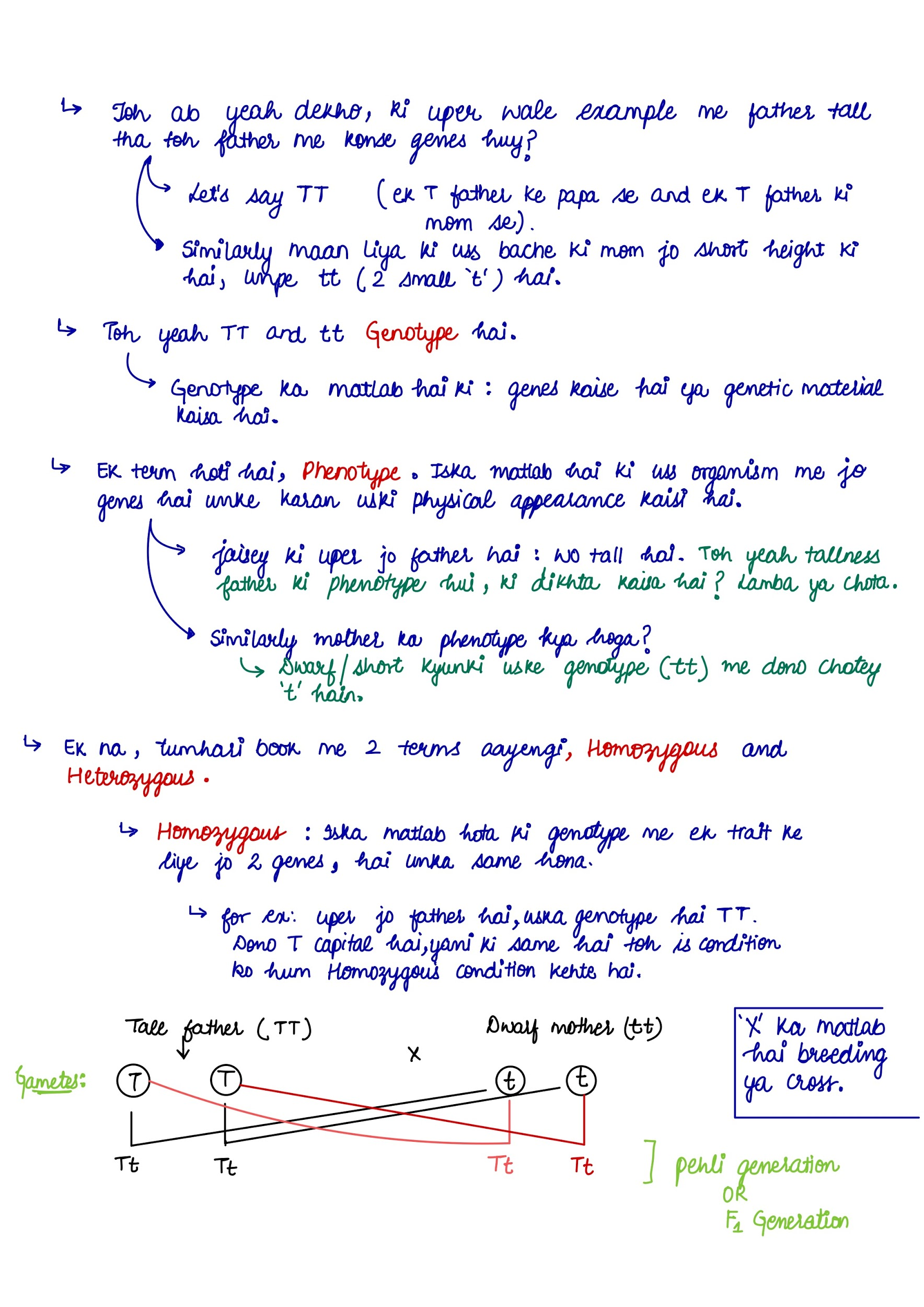

ACCUMULATION OF VARIATION DURING REPRODUCTION
- Variations that occur due to or during sexual reproduction are generally heritable, which means that these variations can be passed from one generation to the next.
- The variations are introduced every time an organism reproduces sexually. So let us have a hypothetical situation where we have a married human couple. Their progeny will have some subtle differences like slight change in hair colour of height or jaw structure or eye colour or skin colour. When these children reproduce the progeny formed by them will have heritable mutations from their parents plus the variations from their grandparents which were inherited by their parents.
- So the heritable variations keep on accumulating in every generation.
- But there’s a catch. Not all of these inherited variations will survive in the environment. Environment always keeps on changing so to survive in a changing environment these variations must change, as consequence some variations are maintained for a longer time period in the environment while others disappear after a few generations because they were not quite very useful to the organism carrying them.
- So only those variations that are necessary for survival or provide some benefit to the carrier survive in the environment while other variations do not survive.
MENDELIAN GENETICS


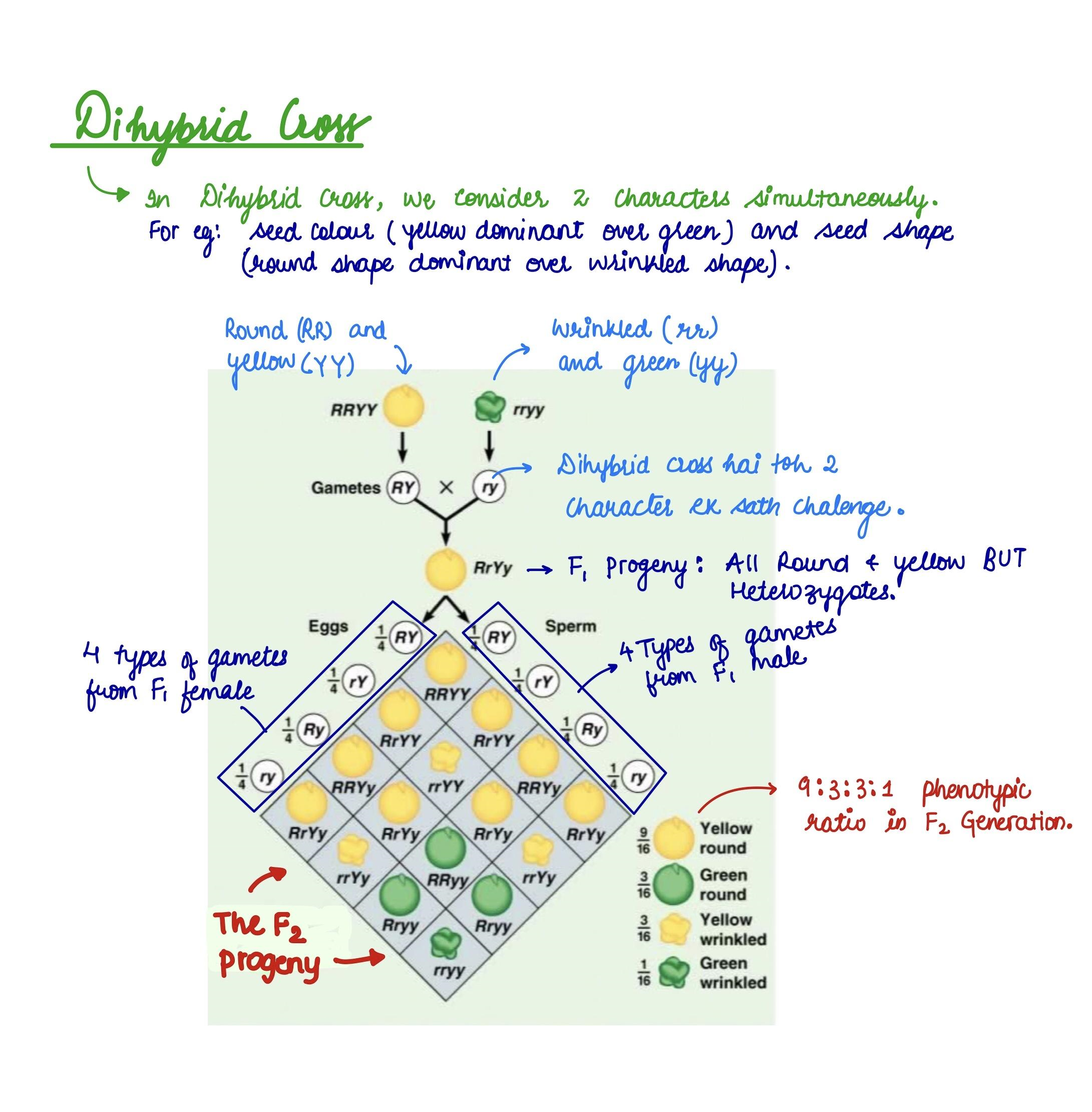
MENDELIAN GENETICS
- Inherited Traits
- Certain features are inherited from one generation to another like height, skin colour, eye colour, hair color etc. these are inherited traits.
- However there are some traits that are acquired (picked) by an organism in his life like muscle mass (that bodybuilder type body), food habits, clothing habits, the ability to differentiate between hot and cold etc. etc. Such traits are acquired traits and these are not passed down the generations.
- Coming back to the inherited traits, humans have two parents : father and mother. So half the DNA of a person is contributed by father and the rest half by mother.
- This means that for each inherited trait there will be two copies/versions of each trait. Like we have a couple where the height of the male is 6’4 and the female is 4 feet. Now their child will have two genes for height : one gene for tall height and another gene for short stature. So which gene will be expressed in the child (this means that will the child be tall or dwarf) ?
This was answered by Mendel and in the following section we will study about Mendel and his contribution in inheritance.
Mendelian Genetics - Mendel did several breeding experiments with pea plants. So he would cross breed on pea plants with other plants having a contrasting pair of characters. For eg : he would breed a tall pea plant with a dwarf plant. He would get many progeny plants known as f1 plants and then he would cross breed them.
- Mendel did this for 7 pairs of contrasting characters. But at this level we would consider tall & dwarf plants, round & wrinkled seeds and green and yellow seeds only.
- The plant which on breeding will always give tall progenies only are known as true breeding tall plants and the dwarf pea plants which on breeding with other dwarf plants only gave the dwarf plants as progenies are known as true breeding dwarf plants.
- Just a little while ago we discussed that for each trait an individual will one copy from mother and other from the father. So Mendel assigned those copies as T for tall and t for short character.
- So the true breeding tall plants were assigned TT (one T from papa and one T from mama) homozygous (both T and T same) and similarly the true breeding dwarf plant was assigned tt (one t for small height from papa and other t for small plant height from mama) which is homozygous for tt.
- He crossed (bred) TT with a tt plant which is written as TT X tt where X denotes breeding. After this he got all F1 plants as Tall plants. Mendel thought ok maybe one plant was Tall so we only got tall plants because the tall plant trait is Dominant over the dwarf trait so only tallness is expressed in F1 which means that all F1 plants are tall.
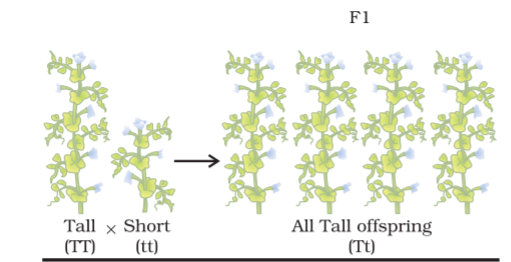
- But then he intercrossed one F1 plant with another and this time Mendel got 1 dwarf plant out of every 4 plants and 3 tall plants out of 4 plants which means that majority of the plants in this F2 generation were tall plants while ¼ of them were dwarf plants.
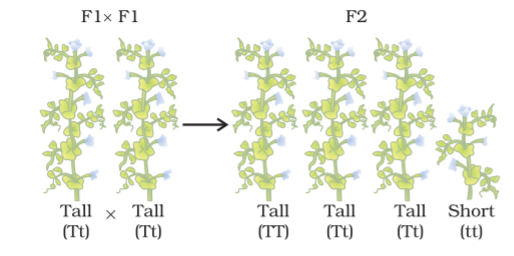
- So when we cross plants with respect to only one trait, for example crossing 2 tall plants or crossing 2 dwarf plants or crossing a tall plant with a dwarf plant; in all these cases we have only one character/trait and that is “height of the plant” whether tall or short. So such crosses involving only one trait are known as monohybrid crosses. Another example of monohybrid cross is given below where the trait is seed colour, whether the colour of the seeds of the pea plant is yellow or green.
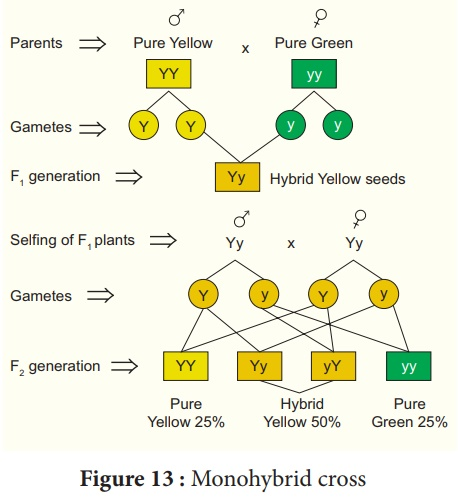
- The ratio in F1 generation is 1:1(in the picture given below) with respect to the phenotype, because all plants are tall, as TT X tt can only produce Tt genotype individual and all of them will be tall. In the F2 generation, we have 1TT, 2Tt and 1tt so the genotypic ratio will be 1:2:1 but in their appearance, both TT and Tt are tall while only individual with Tt is dwarf so out of 4 plants, 3 are tall and 1 is small which means that the phenotypic ratio of F2 generation is 3:1.
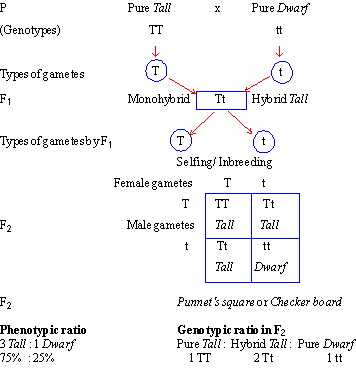
- Mendel after seeing these results realised that some characteristics/traits are dominant over other. For example : Tt plants were always tall instead of having one ‘t’ gene which is responsible for dwarfness. So T is always dominant over ‘t’. Similarly the round shape of the seeds (R) is dominant over the wrinkled (w) shape.
- This was known as the Law of dominance
- There were 2 more laws which we will study in the class 12th and those laws aren’t really relevant here in the 10th standard.
- In the next stage of experiments, Mendel breed plants with two pairs of contrasting character simultaneously. For example : he crossed a pea plant with round shape (RR) and green colored (yy) seed with a plant having wrinkled (rr) and yellow (YY) seeds. He got the following cross :
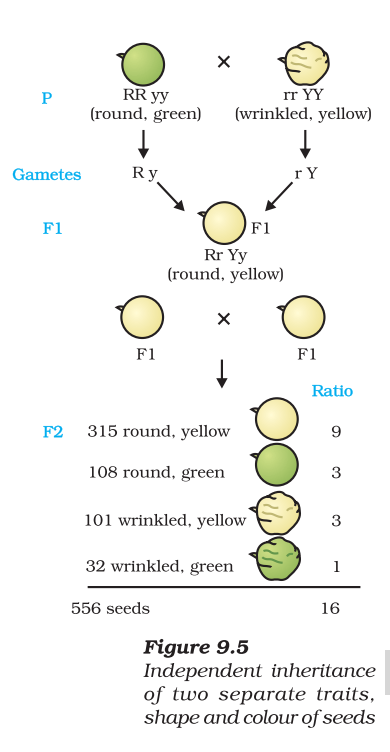
- In F1 all plants were round and yellow although heterozygous. But in F2 generation he got a phenotypic ratio of 9:3:3:1 as shown in the above picture.
MENDEL’S LAWS OF INHERITANCE
DIHYBRID CROSS
KEEP IN MIND
- Mendel didn’t know at that time about genes or chromosomes. So used the term factors to denote the heredity unit that is passed on from parent to progeny.
- He used the term alleles to denote contrasting pairs of characters. Like for example, the factor responsible for tallness is an allele of the factor responsible for the short height of the plant. Or the round shape of the seeds is a allele for the wrinkled shape of seeds.
SEX DETERMINATION
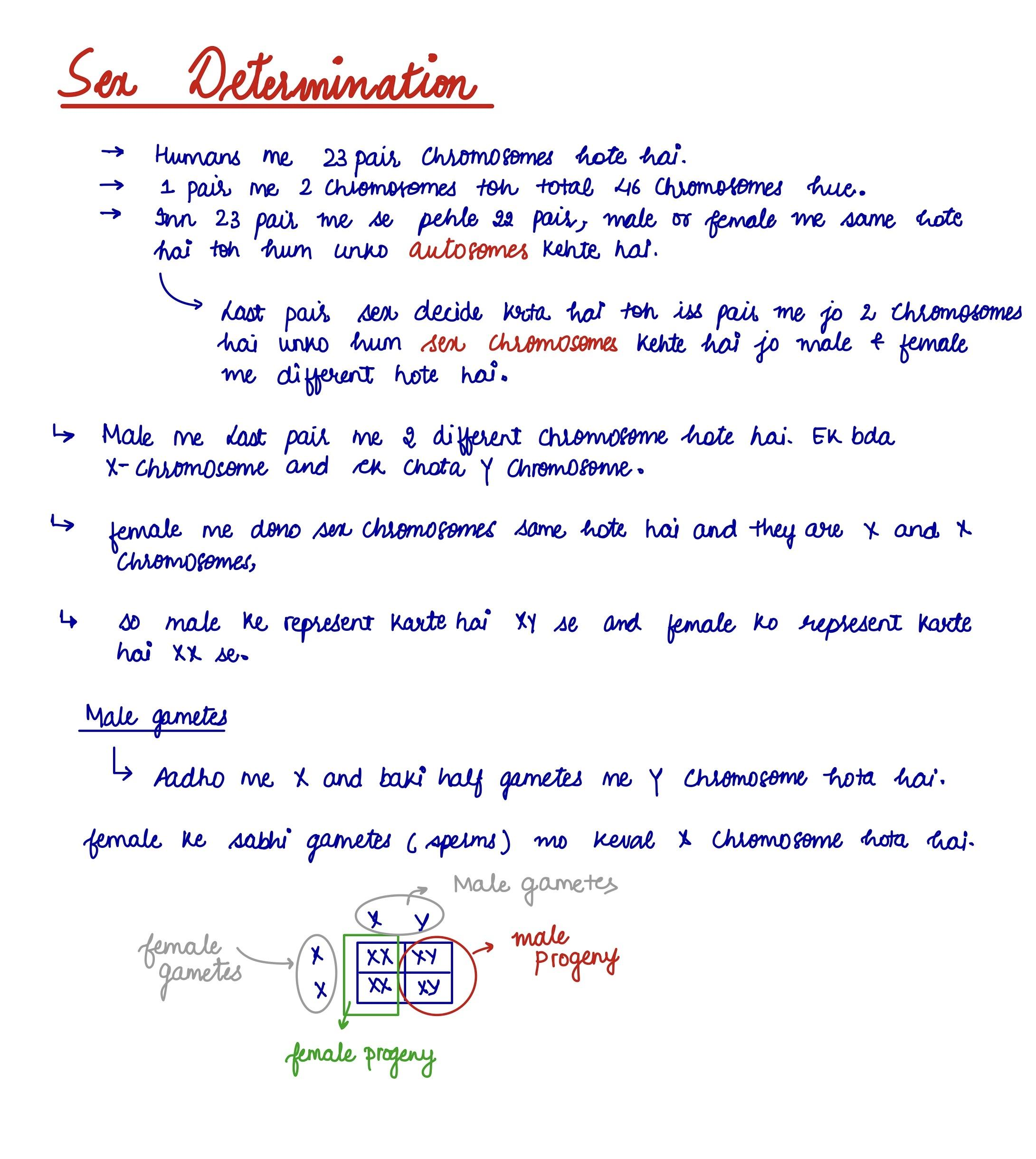
SEX DETERMINATION
- Humans have 23 pairs of chromosomes out of which the first 22 pairs are known as autosomes and these are present in both males and females.
- However, the pair of chromosome (sex chromosomes) is somewhat different in both the sexes in the sense that males have one X chromosome and one short chromosome known as Y chromosome. This Y chromosome is responsible for sex determination.
- The females on the other hand have two X chromosomes.
- So when a male produces gametes, hal of the gametes will carry X chromosome along with one copy of each of the autosome and other half of the male gametes will carry a Y chromosome in addition to the one copy of each of the autosome.
- This means that the male will produce 2 types of gametes : half containing X and other half containing Y chromosome. While females produce only one type of gamete : all with an X chromosome.
- Now when a male gamete with X chromosome fertilises the female gamete, the zygote will be of XX type. Having 2 X chromosomes it will develop into a female embryo. On the other side if a male gamete with Y chromosome fertilises a female gamete then the the resulting zygote will be of XY type and due to the presence of Y chromosome it will develop into a male embryo.
EVOLUTION
- Dekho evolution ka simple sa matlab hai : Kisi species ke ya organism ke genetic material me over the time hone wala inheritable change.
- Hum sabko pta hai ki sexual reproduction ke karan progeny me kuch halke fulke changes aate hai jinko hum variations kehte hai. Yhi variations evolution ka foundation hoti hai.
- Aapki book me ek beetles ka example dekr iss variation and evolution ko interlink kiya gya hai toh hum bhi ab ussi ko padhenge.
- Maanlo, ek group hai red colour ke beetles ka. Yeah sexually reproduce kar rhe hai toh variations hongi. By chance ek aisi variation hui genetic material me jiske karna red ki jagah green colour hogya beetle ka. Ab yeah apna green colour apni progeny pe pass karega toh iss colony me ab kuch red colour ke beetles hai and kuch green colour ke. Beetles green leaves par rehte hai toh green leaves pe green colour ka beetle crow ko aasani se nhi dikhta toh iska shikar nhi kar payega but red beetle ache se dikh rha hai toh usko kha jayega. Ab yhi scenario continued rha and kuch generation ke baad aisa hua ki crow ne sare red colour ke beetles ko kha liya and humari population me keval green colour ke beetles baki hai. Toh yahan par green colour ki variation ne inko ek survival advantage provide kiya toh nature ne iss variation ko select kiya and flourish karne ke azadi di. Toh yhaan se hume ye pta chla ki evolution me natural selection ek ahem bhumika nibhata hai.
- Ab ek or variation dekho jisme blue colour hogya beetle ka. Lekin crow blue colour ko ache se dekh sakta hai toh crow blue ko bhi khayega and red ko bhi. So in this case this blue colour variation provides no survival advantage. Lekin aisa hua ki ek hathi aaya or jhan jis bush pe yeah beetle ki colony thi uspe apna ek leg rakh ke chla gya jiske karan sare red and kuch blue beetles ki death hogyi and ab keval blue beetles hi bache hai toh wo reproduce karke progeny baneyge and ab yeah evolved colony blue colour ki hogyi jo ki originally red colour ki thi and karan hai : ek sudden chance event (hathi ka aana) jo ho bhi sakta tha or nahi bhi. Toh jab aise sudden chance event ke karna evolution ho toh we call this phenomenon as genetic drift.
- Ek third case hai ki maanlo plants ki koi disease aagyi jiske karan ab beetles ko food nhi mil pa rha toh wo bechare patle ho gye and unki body ka weight decrease ho gya. Lekin reproduction toh abhi bhi chalu hai. Unke bache hue and ab bacho ko bhi bharpait khana nhi mila toh bhukh ke karan bacho ka weight kam hai (yaad rakhna ki weight kam hona ek heritable trait nhi hai), lekin kuch time baad plants ki wo bimari chali gyi and ab beetles ko firse pura pura khana mil rha hai toh unka weight firse badh gya. Ab yeah point hume yeah btata hai ki food ki kami ke karan beetles ki genetic material me kuch badlaav nhi aaya or nhi wo badlaav unhone progeny ko pass kiya. Toh evolution keval ussi badlaav ke karan hoga jo badlaav hume genetic material me bhi dkehne ko mile.
- Acquired traits wo hote hai jo koi organism apni jindage ke dauran apne anubhavo se seekhta hai jaise ki swimming karna, koi new language bolna, yeah samjh pana ki chalti gas par rakha hua patila garam hai and usko hath nhi lgana, apni body ka wieght badhana ya decrease karna ya muscle gain karna ya bodybuilding karna. Yeah sab acquired traits hai jo koi apne parents se nahi leta. Yani ki aisa kuch nhi hai ki bodybuilder ka beta bhi bachpan se hume bodybuilder ki tarah hi hatta katta muscle man jaisa dikhe. alright.
- Next is heritable trait. Yeah aise traits ya features jo hum apne parents se pate hai jai jaise ki hair ka colour, eye ka colour, body ki height vgarah yeah sari information genetic material me stored hoti hai toh parents se offspring tak paas ki ja sakti hai and jaise hi iss heritable information me koi bhi badlaav aayega wo badlaav bhi heritable hoga jo evolution me ahem bhumika nibha sakta hai.
Acquired & Inherited Traits
EVOLUTION
- Evolution is defined as : Change in hereditary material over time/over successive generations. Now this fancy line simply means that the process of accumulation of gradual changes in a species over time is simply defined as evolution.
- The word gradual changes that we used in the above line basically means variations, and we all are familiar with the term variation which is an important aspect of sexual reproduction.
- Consider a group of twelve red beetles which live on green leaves. They grow by sexual reproduction, and therefore, can generate variations. Let’s there is a variation due to which a beetle became green coloured instead of being red. Now, crows can’t see green coloured beetle easily on the green leaves but they can easily see the red one so crows will continue to eat the red beetles and over time the population of red beetles will decrease while the population of green beetles will increase. So after many generations we can say that the red beetles have evolved into green beetles. Green colour bhi kisi na kisi gene se banta hai. Right? So the gene responsible for the green colour will now be found in most of the members of the population which means that mathematically we can say that the frequency of that gene is high in the evolved population.
→ Now the question arises why green beetles survived? Answer is simple : they were not seen by the predator/crow. So, this variation which produced a green coloured body in beetles provided them with a Survival advantage over red beetles hence nature selected the green beetles to flourish in an environment where presence of crows or predators was a common thing. So we have established that nature selects an individual (to live and reproduce) which is best suited to survive in that environment. In other words we can say that natural selection is directing evolution in the beetle population. It results in adaptations in the beetle population to fit their environment better. - Let’s say there is another case where the variation results in a blue body colour in the colony of red beetles. Now blue coloured beetles can be easily seen by crows and they will be eaten just the as red beetles. But suppose there’s an accident. An elephant walks by and stomps over the bush where this colony of beetles live and elephant’s foot crushes all the red beetles and some blue beetles so that now only a few blue beetles survive in that population. The progeny of these blue beetles will also be blue again leading to an evolutionary event where the population becomes blue coloured from red body colour.
→ The important thing to know in this case is that this time natural selection didn’t play a role because the blue body colour didn’t provide any survival benefit against the predator but still after evolution all the beetles are blue coloured. The reason is that accident or that chance event. So when a sudden change leads to diversity we call it genetic drift. - Now consider a third situation. In this, as the beetle population begins to expand, the bushes start suffering from a plant disease. The amount of leaf material for the beetles is reduced. The beetles are poorly nourished as a result. The average weight of adult beetles decreases from what it used to be when leaves were plentiful, but there is no genetic change occurring. After a few years and a few beetle generations of such scarcity, the plant disease is eliminated. There is a lot of leaf food. At this time, the body weight will increase and bounce back to the initial values.
- Any trait that we acquire during our lifetime is known as an acquired trait like bodybuilding or weight changes or learning a new language. These traits can’t be passed from generation to generation. Progeny acquires them according to their needs and interests.
- A trait which is passed down from parent to offspring is known as inherited trait like eye colour, height of the individual, tone of the skin colour are all inherited traits.
- Consider another example of how an individual cannot pass on to its progeny the experiences of its lifetime. If we breed a group of mice, all their progeny will have tails, as expected. Now, if the tails of these mice are removed by surgery in each generation, do these tailless mice have tailless progeny? The answer is no, and it makes sense because removal of the tail cannot change the genes of the germ cells of the mice. This is the reason why the ideas of heredity and genetics that we have discussed earlier are so essential for understanding evolution.
- Charles Darwin came up with the idea of evolution of species by natural selection in the nineteenth century, could not work out the mechanism. - this was one of the limitations of the concept of evolution due natural selection) given by Darwin.
- Darwin’s theory of evolution tells us how life evolved from simple to more complex forms and Mendel’s experiments give us the mechanism for the inheritance of traits from one generation to the next.

Example of Beetles :
Acquired & Inherited Traits
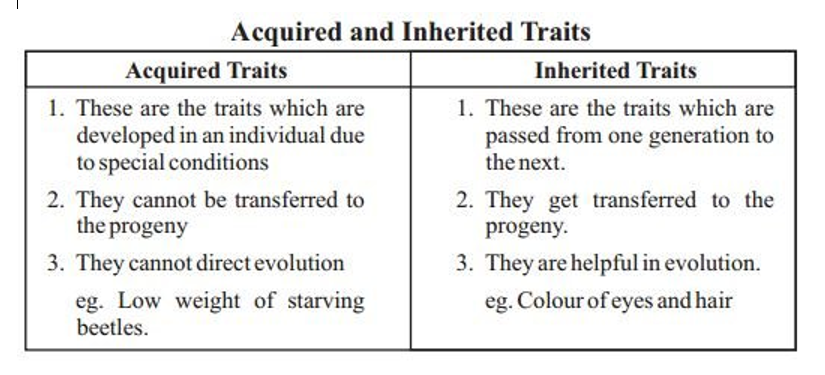
SPECIATION
- Ab dekho jo green colour ke beetles bane na uss ek bush tak limited hai wo. Lekin uss area me or bhi bahut sare original beetles hai yani ki red colour ke jinme as such abhi tak yeah variation nhi hui. Toh hai toh sare ke sare hi beetles ek hi population se lekin kuch me kuch badlaav aagya toh green walo ko ab humne sub population keh diya. Aise hi over time inme changes hote rahe ho kuch changes aise hue jinke karan green beetles red ke sath reproduce nhi kar pate hai toh hum inko 2 alag alag species ghosit kar denge. Do alag alag species me aise organisms hote hai jo ek dusre ke sath reproduce nhi kar pate.
- Bahut sare karano se ye ho sakta hai jaise ki red and green beetles ke DNA me severe changes aana, chromosomes ke number change hona ya aisi variation jisme green females red males ko as a mate consider hi nahi karti toh in sab karano se ek nyi species ki utpatti hoti hai and issi phenomenon ko hum speciation kehte hai.
SPECIATION
- Speciation simply means origination or evolution of a new species from an existing population. Till now we were talking about beetles on a particular bush which became green coloured out of all the existing beetles on the whole continent. This evolution on a smaller scale leads to micro-evolution. Now imagine the same thing happens to all the beetles of that area and they all change from red to green colour. These green beetles in that area now represents a separate population of beetles and over time some variations will keep on accumulating in green ones and some other variations might accumulate in the other red beetles of that continent eventually making these green beetles a different species from red one. So the formation of new species is what we call speciation.
- Together, the processes of genetic drift and natural selection will result in these two isolated sub-populations of beetles becoming more and more different from each other. Eventually, members of these two groups will be incapable of reproducing with each other even if they happen to meet. There can be a number of ways by which this can happen. If the DNA changes are severe enough, such as a change in the number of chromosomes, eventually the germ cells of the two groups cannot fuse with each other. Or a new variation emerges in which green females will not mate with red males, but only with green males. This allows very strong natural selection for greenness. Now, if such a green female beetle meets a red male from the other group, her behaviour will ensure that there is no reproduction between them. Effectively, new species of beetles are being generated.
EVOLUTION AND CLASSIFICATION
- Hum na evolution ke base pe actually organisms ko classify kar sakte hai kyunki jin jin organisms ka ek common ancestor hota hai unme number of similar characters jyada hote hai as compared to number of dissimilar characters. For ex : Lion, Tiger and Cat basically common ancestry share karte hai and bahar se different dikhne wale in animals me jo common ancestry hai ussi ko hum phylogeny kehte hai and iss phylogeny ko base bnakr jo hum inn animals ko dusre animals se separate karenge ya classify karenge toh classification ka yeah tarika phylogenetic classification kehlata hai.
- Ab problem aati hai yeah dekhne me ki bhyii kaise pta kare ki kitne similar characters hai and konse similar characters ko hum actual me classification ke liye use kar sakte hai.
- Homologous Organs : Yeah aise organs hote hain jinka origin same hota hai but yeah different different animals me different function perform kar sakte hai. For example : forelimbs of frog, lizard, birds and human perform different functions but their bones have more or less similar arrangement because all these different organisms had a common ancestor and jaise uss ancestor me forelimb me bones arranged thi aise hi inme arranged hai. Wo toh in sabki habitat and needs alag alag hai toh forelimbs inke different different functions performs karte hai.
- Analogous Organs : yeah aise organs hai jinke function same hote hai par origin different hai. Have a look at wings of a bird and bats. Dono ke wings hai and dono me wings ka function flight ka hai but beta inme dekho jo bones ki arrangement hai wo kafi alag hai kyunki birds and bats ke wings ek common ancestry share nhi karte. Toh har wo feature jo ak jaisa kaam karta hai wo ek common feature nahi ho sakta kyunki uska origin different ho sakta hai.
- Fossils : Ek samay par jo living organism the, unki presence ke kuch preserved saboot jaise ki unki bachi hui bones, ya bache hue foot prints ya ice me preserved complete body : jo hume yeah btate hai ki ek time par prithvi par aise organism bhi jinda rehte thy, inhi preserved traces ko hum fossils kehte hai.
- Fossils generally soil me dabey hue milte hai toh jo fossil prithvi me jitna gehra dba hua hoga wo utna hi purana hota hai.
- Carbon dating ek or dusra tareka hai jo hume lagbhag accurate age btata hai kisi bhi fossil ki.
- Dekho evolution na kabhi bhi ek single step me nhi hota. Hamesha choti choti steps me hoga. Definition hi hai hai : slow and gradual changes yani ki dheere dheere hote rehne wale changes kisi bhi organism ke genetic material me jo heritable changes wo evolution me role play karte hai.
- Simple sa example lete hai ki jo eyes haina wo sabse pehli bar jab develop honi shuru hui toh toh literally aise dots the jo bas yeah detect kar pate thy ki light jaisa kuch hai ya na.
- Fir dheere dheere new changes hona shuru hue and humans me dekho eyes fully developed hai.
- Har organism me eyes alag alag hai yani ki jaisi humans ko duniya dikhti hai colourful si baki animals me bhi eyes hai but unko aisa nhi dikhta, kisi ko colours kam dikhte hai kisi ko colour n=hi nhi dikhte , kuch animals ki eyes andhere me dekhne ke liye jyada adapted hai jabki eagle ki aankhein itni tez hai ki wo sky me udte udte apna shikar dekh leta hai.
- Jab pehli baar feathers develop hue thy toh unka kaam tha uss animal ki body ko warm rakhna and thand se bachana lekin birds me aate aate feather ka specialised function body ko heat provide karne se change hokr flight me help karna ho gya. Toh udne wale father banne me bhi hazaro saal lage or dheer sari different choti choti variation accumulate hui tab jakr fully functioning wings bany hai.
- Same aise hi humans ne wild cabbage ke different traits ko selectively breed karwa karwa kar wild cabbage ka evolution karwa diya and now we have different types of cabbages like Kohlrabi, Broccoli, Cauliflower, Cabbage, Red cabbage etc. In different types ki cabbages ko humans ne select kiya and breed kiya toh yeah example artificial selections ka hai.
Toh humare pass yahan par ab 2 terms aayengi : Analogous and Homologous organs.
Evolution by Stages
EVOLUTION AND CLASSIFICATION
- On the basis of evolution we can actually classify organisms because we know about their ancestors like tiger, lion, cat- they all evolved from a common ancestor so we can group these animals together even though they do not look the same but they do share the same common ancestor.
- This evolutionary relationship between different organism is known as phylogeny and the classification based on these evolutionary relationships is known as phylogenetic classification.
- To establish evolutionary relationships we need to know which characteristics are common and which are different. Characteristics in different organisms would be similar because they are inherited from a common ancestor. As an example, consider the fact that mammals have four limbs, as do birds, reptiles and amphibians. The basic structure of the limbs is similar though it has been modified to perform different functions in various vertebrates. Such a homologous characteristic helps to identify an evolutionary relationship between apparently different species. Homologous basically means the same origin but functionally they could be different.
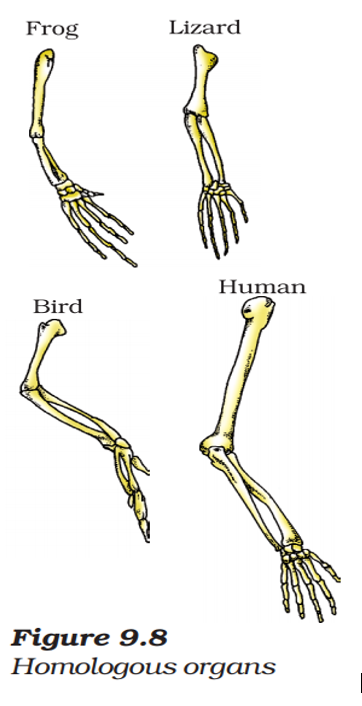
- As we know both birds and bats have wings and wings perform the same function in both the organisms but that doesn’t mean ki birds are actually related to bats because the structure of bones in wings of bats and birds are totally different which suggests that they do not have a common ancestor meaning that they are not closely related to each other. Such organs whose origin is different but they have the same function like wings of birds and wins of bat are known as analogous organs.

- Usually, when organisms die, their bodies will decompose and be lost. But every once in a while, the body or at least some parts may be in an environment that does not let it decompose completely. If a dead insect gets caught in hot mud, for example, it will not decompose quickly, and the mud will eventually harden and retain the impression of the body parts of the insect. All such preserved traces of living organisms are called fossils.
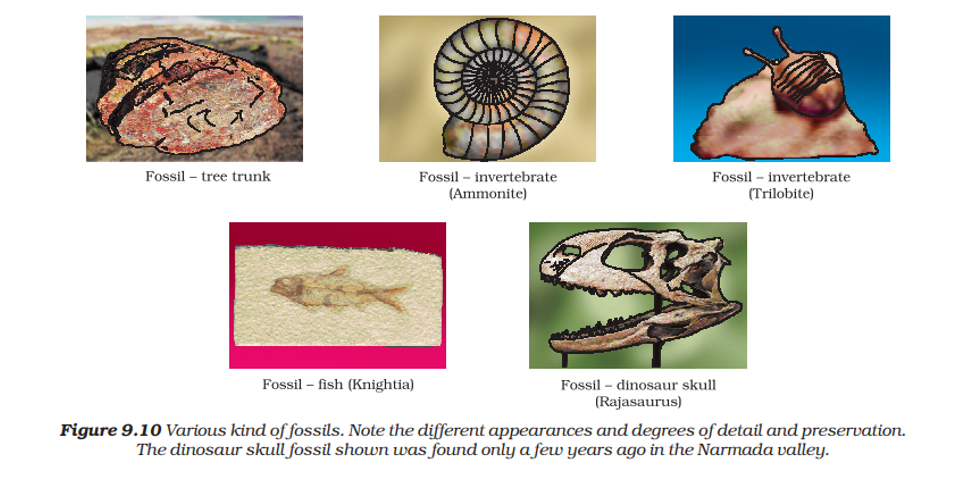
- To get an idea about the age of the fossil, the deeper the fossil is discovered the more aged it is than the ones found above them. This method just gives an idea but we can actually determine the age of a fossil by a method known as carbon dating.
- Evolution is basically defined as the slow and gradual change in the genetic material of an organism. So the word slow and gradual change basically means that evolution occurs in stages. It is never the case that a single change in DNA causes evolution.
- For example earlier animals didn’t have eyes but most of the animals like dog, cat, humans do have eyes. The eyes started to develop as structures which could simply detect presence or absence of light. But over the time these rudimentary structures kept evolving into better and better structures and now we have fully functioning eyes. Even the eyes of different species like humans, dogs, cats, eagle, deer are all different because they have different origins but they all do perform the same basic function that eyes do so they are analogous organs.
- Feathers, for example, can start out as providing insulation in cold weather. But later, they might become useful for flight. In fact, some dinosaurs had feathers, although they could not fly using the feathers. Birds seem to have later adapted the feathers to flight. This, of course, means that birds are very closely related to reptiles, since dinosaurs were reptiles!
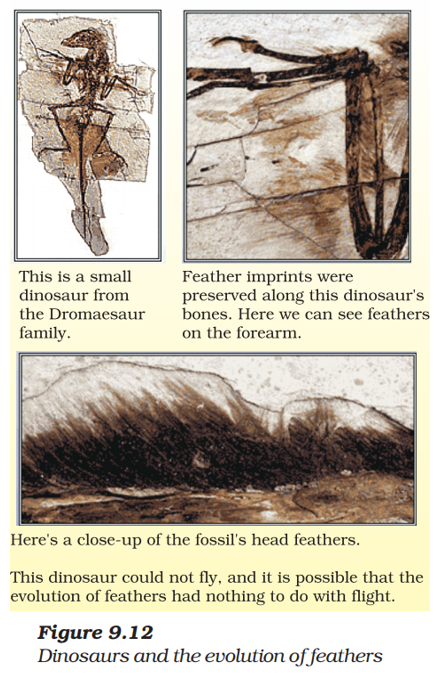
- Humans have, over more than two thousand years, cultivated wild cabbage as a food plant, and generated different vegetables from it by selection. This selection done by man (and not by nature itself) for its own advantage is known as artificial selection.
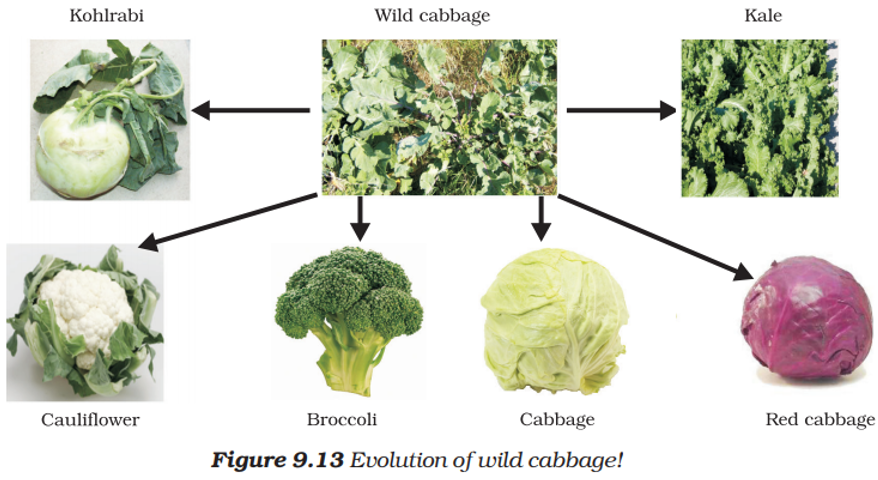
- Comparing the DNA of different species should give us a direct estimate of how much the DNA has changed during the formation of these species. This method is now extensively used to define evolutionary relationships.
Tracing Evolutionary Relationships
Fossils
Evolution by Stages
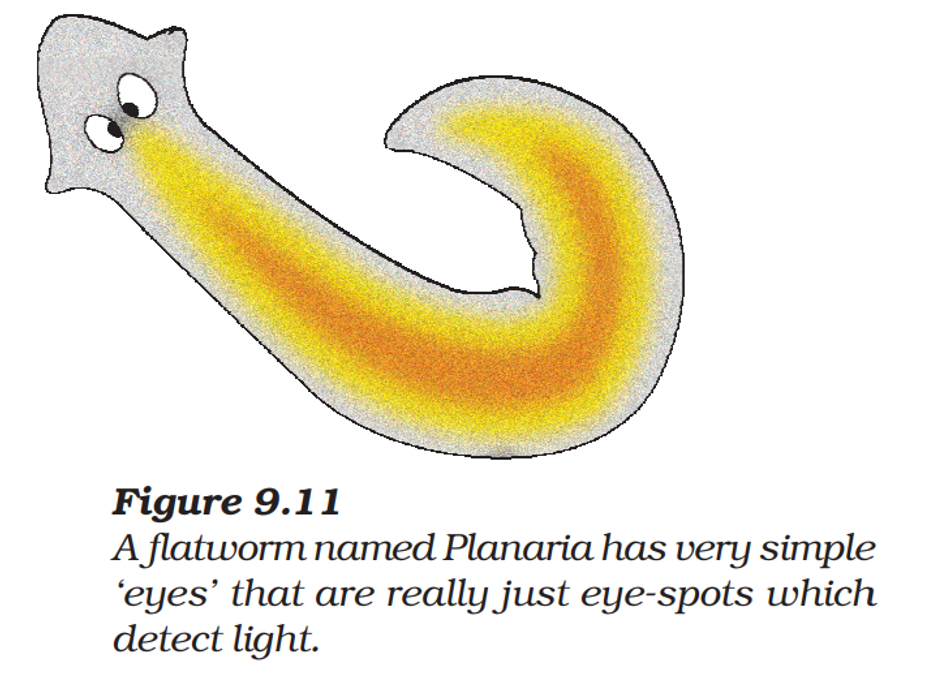
EVOLUTION & PROGRESS
- Evolution ko hamesha progress se relate nahi karna chahiye kyunki evolution ka matlab hamesha progress nhi hota. Evolution basically diversity generate karta hai. Jo new population bnti hai evolution se wo hamesha better nhi hoti and yeah bhi matlab nhi nikalna chahiyeah ki old life forms ab life me utni kabil nhi hai jitni ki new species. Ek example blue beetles ka humare samne hi hai ki blue colour ne koi survival advantage nhi diya lekin fir bhi wo beetles ki population me tha, reason hai - genetic drift (sudden chance event). Bacteria sabse pehle organisms me se hai and sabse purana living cell hai iss earth pe, lekin wo abhi bhi jinda hai. Agar aisa hota ki purane bacteria inefficient hai toh puri tarah lupt ho chuke hote but still abhi kuch aise bacteria hai jo jaise hazaro saal pehle thy abhi bhi unka genetic material waisa hi hai.
- Humans ka evolution Chimpanzee se nhi hua hai. Bahut hazaro saal pehle Chimpanzees and human ka koi ek common ancestore rha hoga jo na toh chipanzee tha or na puri tarah se human.
- Sabhi humans Africa se aaye hain. Humare ancestors pehle Africa me rehte thy, vhan se kuch baki desho ki taraf migrate kar gye or kuch vhi base rahe.
- Kuch Africa se West Asia aagye, kuch Central Asia aa gye koi Eurasia chla gya toh kuch Asia ke baki parts me rehne lag gye.
- Different environment and selective breeding ke karan inki appearances me kuch change aa gaye lekin iska yeah matlab nhi ki or dusri species hain. Hum sab abhi bhi ek dusre ke sath reproduce kar sakte hai toh all humans are a single species.
Evolution of Humans
EVOLUTION & PROGRESS
- EVOLUTION SHOULD NOT BE EQUATED WITH ‘PROGRESS’.
- Whenever a new species emerges from an old population (like blue beetles from red ones), it doesn’t mean that old species will perish or that the new species is anyhow ‘better’ than the previous one. LIke blue beetles had no survival advantage but they still were there in the population due to a chance event (elephant’s foot).
- It is not true that human beings have evolved from chimpanzees. Rather, both human beings and chimpanzees have a common ancestor a long time ago. That common ancestor is likely to have been neither human or chimpanzee.
- In fact, there is no real ‘progress’ in the idea of evolution. Evolution is simply the generation of diversity and the shaping of the diversity by environmental selection. The only progressive trend in evolution seems to be that more and more complex body designs have emerged over time. However, again, it is not as if the older designs are inefficient! So many of the older and simpler designs still survive - like the Bacteria.
- There is a great diversity of human forms and features across the planet. So much so that, for a long time, people used to talk about human ‘races’. Skin colour used to be the commonest way of identifying these so called races. Some were called yellow, some black, white or brown.
- All humans are a single species.
- We all humans come from Africa. A couple of hundred thousand years ago, some of our ancestors left Africa while others stayed on.
- While the residents spread across Africa, the migrants slowly spread across the planet – from Africa to West Asia, then to Central Asia, Eurasia, South Asia, East Asia. They travelled down the islands of Indonesia and the Philippines to Australia, and they crossed the Bering land bridge to the Americas.
- They did not go in a single line, so they were not travelling for the sake of travelling, obviously. They went forwards and backwards, with groups sometimes separating from each other, sometimes coming back to mix with each other, even moving in and out of Africa.
Human Evolution
SUMMARY
- Heredity : It refers to the transmission of characters or traits from the parents to their offspring. Heredity is the continuity of features from one generation to another which are present in fertilised egg or zygote. The zygote develops into an organism of a particular type only.
- Genetics : It is the branch of biology which deals with heredity and variation. Genetics is to help our understanding of heredity by knowing how offspring inherit characteristics from their parents.
- Variation : It means the differences in the characters or traits among the individuals of a species. Variations occur during reproduction both because of error in DNA copying and as a result of sexual reproduction. Variations contribute to evolution.
- Variations arising during the process of reproduction can be inherited.
- These variations may lead to increased survival of the individuals.
- Sexually reproducing individuals have two copies of genes for the same trait. If the copies are not identical, the trait that gets expressed is called the dominant trait and the other is called the recessive trait.
- Traits in one individual may be inherited separately, giving rise to new combinations of traits in the offspring of sexual reproduction.
- Sex is determined by different factors in various species. In human beings, the sex of the child depends on whether the paternal chromosome is X (for girls) or Y (for boys).
- Variations in the species may confer survival advantages or merely contribute to the genetic drift.
- Changes in the non-reproductive tissues caused by environmental factors are not inheritable.
- Speciation may take place when variation is combined with geographical isolation.
- Evolutionary relationships are traced in the classification of organisms.
- Tracing common ancestors back in time leads us to the idea that at some point of time, non-living material must have given rise to life.
- Evolution can be worked out by the study of not just living species, but also fossils.
- Complex organs may have evolved because of the survival advantage of even the intermediate stages.
- Organs or features may be adapted to new functions during the course of evolution. For example, feathers are thought to have been initially evolved for warmth and later adapted for flight.
